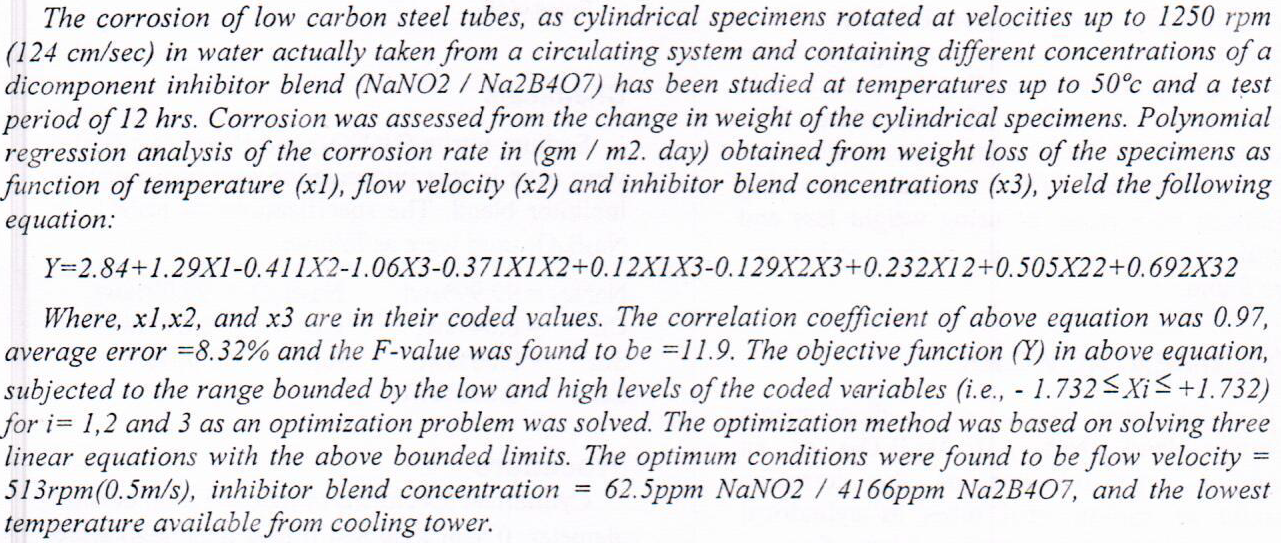
The approach of green synthesis of bio-sorbent has become simple alternatives to chemical synths as they use for example plant extracts, plus green synthesis outperforms chemical methods because it is environmentally friendly besides has wide applications in environmental remediation. This paper investigates the removal of ciprofloxacin (CIP) using green tea nano zero-valent iron (GT-NZVI) in an aqueous solution. The synthesized GT-NZVI was categorized using SEM, AFM, BET, FTIR, and Zeta potentials techniques. The spherical nanoparticles were found to be nano zero-valent, with an average size of 85 nm and a surface area of 2.19m2/g. The results showed that the removal efficiency of ciprofloxacin depends on the initial pH (2.5-10),
... Show More (7)
(7)
 (2)
(2)
This study evaluates the flexural behavior of ultra-thin (50 mm) one‑way reinforced‑concrete (RC) slabs retrofitted with near‑surface mounted (NSM) carbon‑fiber‑reinforced polymer (CFRP) rods under quasi‑static loading. T300‑grade CFRP rods (≈4 mm diameter) were bonded in pre‑cut 7 mm × 7 mm grooves using a two‑part epoxy. As a proof-of-concept experimental baseline, three simply‑supported specimens (1000 mm × 500 mm × 50 mm) were tested in a six‑point bending configuration (four applied loads + two reactions): two conventional controls and one strengthened slab. A load‑control rate of ~15 kN/min was applied; the controls were cycled twice and the strengthened slab four times. Relative to the average of
... Show More (10)
(10)
 (1)
(1)
 (1)
(1)
 (14)
(14)
 (13)
(13)
 (1)
(1)
 (1)
(1)
Coagulation - flocculation are basic chemical engineering method in the treatment of metal-bearing industrial wastewater because it removes colloidal particles, some soluble compounds and very fine solid suspensions initially present in the wastewater by destabilization and formation of flocs. This research was conducted to study the feasibility of using natural coagulant such as okra and mallow and chemical coagulant such as alum for removing Cu and increase the removal efficiency and reduce the turbidity of treated water. Fourier transform Infrared (FTIR) was carried out for okra and mallow before and after coagulant to determine their type of functional groups. Carbonyl and hydroxyl functional groups on the surface of
... Show MoreBackground: preparation of root canals is an important step in root canal treatment. Mechanical instrumentation of root canals cause an irregular layer of debris, known as the smear layer. As a result, several studies reported that preferring the removal of the smear layer. Objective: To study the influence of the energy (100 mJ) of Erbium, Chromium: Yttrium Scandium Gallium Garnet (Er,Cr:YSGG) laser at short pulse duration (60 μs) on smear layer removal of apical third after using Photon induced photoacoustic streaming technique. Materials and methods: Eighteen straight single-rooted mandibular premolars were used. The roots length were uniform to 14mm from the anatomic apex and
... Show MoreTime-domain spectral matching commonly used to define seismic inputs to dynamic analysis in terms of acceleration time history compatible with a specific target response spectrum is used in this study to investigate the second-order geometric effect of P-delta on the seismic response of base-isolated high-rise buildings. A synthetic time series is generated by adjusting reference time series that consist of available readings from a past earthquake of the 1940 El Centro earthquake adopted as an initial time series. The superstructure of a 20-story base isolated building is represented by a 3-D finite element model using ETABS software. The results of the base isolated building show that base isolation technique significantly reduces inter-s
... Show More